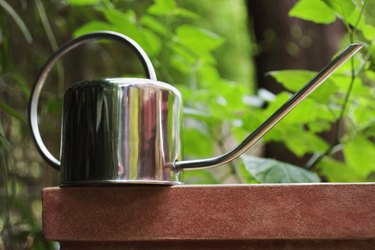
Ficus lyrata, commonly called fiddle leaf fig, grows in the warm climates of U.S. Department of Agriculture plant hardiness zone 10 through 12 and also grows as a houseplant. Once removed from its rainforest environment, it is undemanding but not indestructible. Problems with this big-leaved tree typically involve either drafts, water or light.
Fiddle Leaf Fig Facts
Video of the Day
Fiddle leaf fig comes from a semitropical environment where it thrives in fast-draining soil enriched with organic matter from decaying plant matter. Although it will often grow up to 100 feet tall and 60 feet wide as part of the forest canopy, fiddle leaf fig grows best in medium light as a houseplant but seldom grows more than 10 feet tall. Fiddle leaf fig gets its name from the dark green 18-inch leaves. Like other figs, fiddle leaf fig stems and branches ooze a sticky, milky white sap when cut.
Video of the Day
Shock
Houseplants have one strike against them because they grow out of their tropical element. They also live part of their lives in greenhouses, with controlled environments. Fiddle leaf fig is especially sensitive to the transition from greenhouse to a home where central heating and air conditioning lead to dry air. That -- and because homes frequently stay in the nighttime range for tropical environments -- makes a move to a new environment difficult. Fiddle leaf fig leaves may turn brown, beginning around the edges, droop and eventually drop when moved to a new environment, such as outside for summer or inside in fall. The plant also shows symptoms of shock when chilled below 50 degrees Fahrenheit or it encounters drafts from windows, doors or forced air ducts.
Water
Don't give your plant a cup of water each week and assume that's correct. Lots of factors affect how much water a plant needs. Organic content, drainage holes and porous clay or impervious plastic containers -- all control how quickly water drains through the soil. A fiddle leaf fig needs moist, but well-drained soil to stay healthy. The plant will suffer when it gets too little water, or too much water, which drowns roots and encourages bacterial leaf spot. Over- or under-watering can lead to browning, drooping leaves. Water carefully and replace soggy soil to fend off fungus and root rot.
Light
Although fiddle leaf fig often provides shade for other plants in its native environment, plants grown in greenhouses live in partial shade to prepare them for their ultimate medium- and low-light destinations. When these plants sit in a south window or on a sunny summer patio, their leaves suffer sunscald and turn brown. Harsh sun can result in dead or drooping leaves. When the leaves turn brown and drop off on a fiddle leaf fig -- for any reason -- they will not grow back, so a quick diagnosis is important.
- Missouri Botanical Garden: Ficus Lyrata
- University of Arkansas Plant Pathology: Fiddle Leaf Fig
- Farm Life Nursery: Ficus Lyrata
- North Carolina State University Extension: Interiorscape Integrated Pest Management
- University of California Statewide Integrated Pest Management Program: Ficus, Fig, Indian laurel, Laurel fig—Ficus spp. Family Moraceae (Mulberry family)